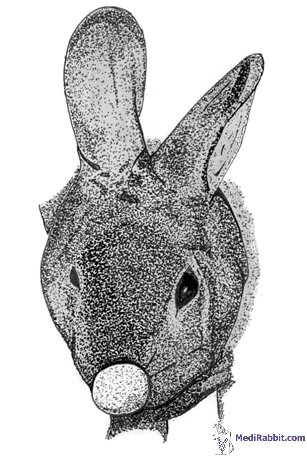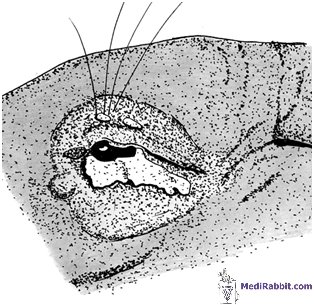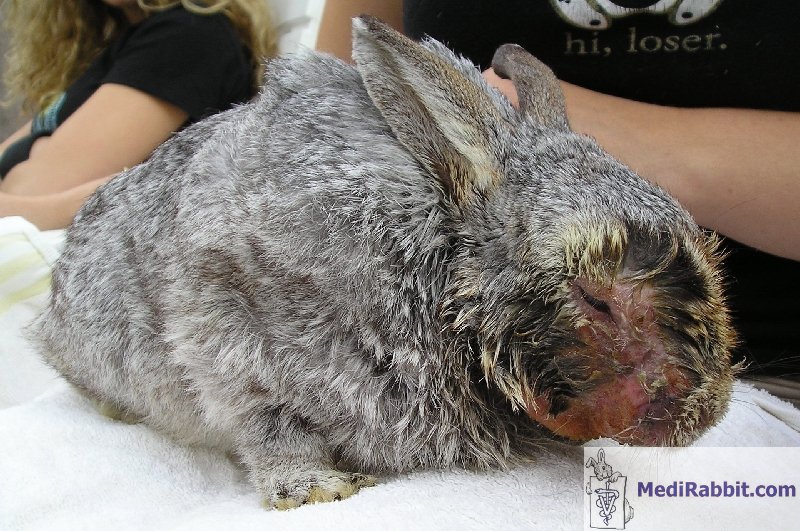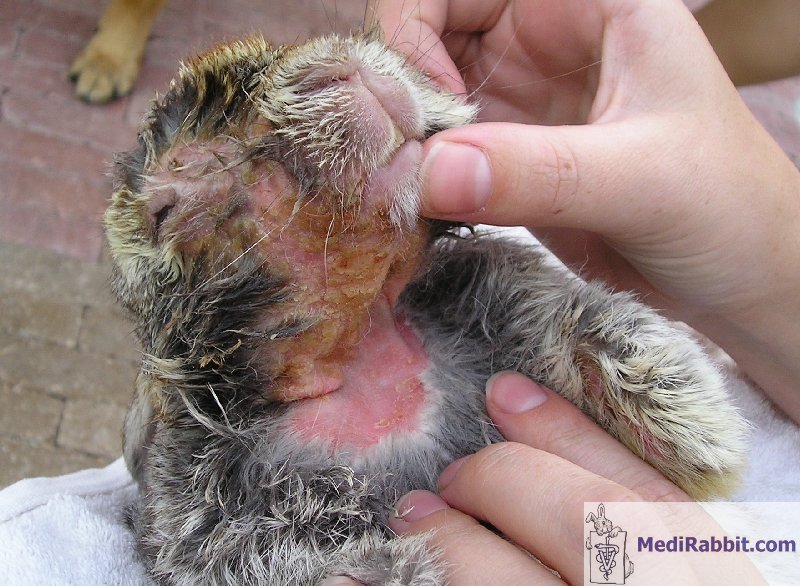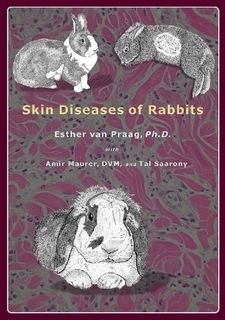Myxomatosis
Esther van Praag Ph.D.
MediRabbit.com wordt uitsluitend gefinancierd door gevers.
Elke donatie, ongeacht hoe groot, wordt gewaardeerd en zal helpen bij de voortzetting van het onderzoek van de medische zorg en de gezondheid van konijnen.
Bedankt
|
Deze ziekte komt
oorspronkelijk uit Uruguay en is in 1896 door Sanarelli ontdekt. Snel werd
bemerkt dat deze virus bij het Europese wilde konijn (Oryctolagus cuniculi)
verschrikkelijke slijmerige huidabcessen veroorzaakt, die uiteindelijk de
dood ten gevolge hebben.
De virus heeft zich
over het gehele Amerikaanse continent verspreid en komt hier en daar
endemisch voor (Chili, in O. cuniculi, Westen van USA, in Sylvilagus
bachmani). In de 50-er jaren, is het myxomatose virus in Australië onder
wilde konijnen verspreid, om de bevolkingsdichtheid van dezen terug te
brengen. Het resultaat is dat bijna alle wilde konijnen, op een paar
resistente dieren na, uitgeroeid waren. Dezen hebben zich opnieuw kunnen
vermeerderen en hebben het land daarbij opnieuw gekoloniseerd.
In Europa is het virus een paar jaar later binnen gekomen
en heeft zich razend snel verspreid, en komt nu in sommige streken endemisch
voor. Het meest getroffen door deze virus zijn: het Europese wilde konijn (O.
cuniculi), de Europese veldhaas (Lepus europaeus), de
Alpensneeuwhaas (Lepus timidus), de Tapeti (S. brasiliensis),
de Brush Katoenstaart (S. bachmani) en de Oostelijke Katoenstaart (S.
floridanus).
Myxomatose
is een virus uit de pokken familie, er bestaan verschillende variaties van
deze ziekte, sommigen zijn virulent, zoals de; Standard Laboratory, Lausanne
en California. Andere variaties zijn chronisch. Genetische studies tonen verwantschap met het Shope fibroom virus
(zie: Fibromatosis). De
ziekte wordt verspreid door insecten, zoals vlooien, muggen, muskieten,
luizen en mijt. Vermoed wordt dat ook huid tot huid contact genoeg kan zijn
om de ziekte tussen konijnen te verspreiden. Klinische verschijnselen
De kwaadaardigheid van
myxomatose hangt van de variant af. De eerste tekenen van de ziekte
verschijnen na 3 dagen op het hoofd: als eerste zwellen de oogleden op
(oedemen), gevolgd door opgezwollen lippen, geslachtsorganen en purulente
oogbindvlies-ontsteking, die in een later stadium tot blindheid leidt.
Bij de chronische vorm van myxomatose verschijnen huid
tumors, voornamelijk op oren, neus en poten. Deze verdwijnen meestal
spontaan. Een gevolg van deze minder ernstige vorm van de ziekte is dat ze
meestal pneumonie veroorzaakt door de bacteriën Pasteurella multocida
en Staphiloccoccus aureus. Vaak gaat deze pneumonie gepaard met
ademhalings moeilijkheden (dyspnoea). De dood treedt meestal tussen de 8ste
en 15de dag op.
Diagnose
Although
the disease depends on the strain of myxoma virus, it is usually severe and
almost always fatal. The
clinical symptoms are sufficient for diagnosis. One must keep in mind though,
that early stages of the spirochetosis disease (caused by the parasite Treponema
sp., affecting the perianal parts of the rabbit) look similar to those of
myxomatosis. Indeed, tumors of those diseases show close similarities, so
spirochetosis and myxomatosis must be carefully differentiated from each
other. Myxomatosis
should furthermore be differentiated from an upper respiratory infection,
like e.g. Pasteurellosis. In the later, no swelling is observed in the
perianal region, on the contrary to myxomatosis.
In
the case of chronic myxomatosis, it is recommended to do a biopsy and check
it for the presence of viruses.
Treatment
Bij de agressievere vormen van deze ziekte is de kans van overleven
van een konijn nihil. Daardoor wordt meestal aangeraden het dier op
"humane" wijze in te laten slapen. Als er toch voor een behandeling gekozen wordt, is deze meestal,
langdurig zwaar en intensief aan verpleging. Het is belangrijk het zieke
konijn in een verwarmde omgeving te houden (21-22°C). Ogen en neus moeten
regelmatig schoon gehouden worden. Gedurende de behandeling is het aanbevolen
om zowel vocht als voedsel toe te dienen, ondanks het feit dat zieke konijnen
meestal goed blijven drinken. Als er huidtumors aanwezig zijn, kunnen
deze operatief verwijderd worden. Op
een gegeven moment treden er secondaire complicaties op, zoals longziektes en
pneumonie, veroorzaakt door Pasteurella spp of Staphilococcus spp. Konijnen, die met de subacute vorm van myxomatose besmet zijn, genezen
spontaan. Om longcomplicaties te vermijden, kan antibiotica gegeven worden. Depending
on the vaccine used and the age or breed of rabbits, vaccinated rabbits may
develop a mild to serious form of the disease. In rare cases, the rabbit must
be put to sleep.
For verdere informatie over
myxomatosis bij konijnen, by E. van Praag, A.
Maurer and T. Saarony, 2010, 408 paginas. $85.- Bemerking
A special thanks to Denise Baart, for
sharing the pictures of her rabbit Bucks. Verdere informatie
Best SM, Collins SV, Kerr PJ.
Coevolution of host and virus: cellular localization of virus in myxoma virus
infection of resistant and susceptible European rabbits. Virology. 2000;
277(1):76-91. Boag B. Observations on the
seasonal incidence of myxomatosis and its interactions with helminth parasites
in the European rabbit (Oryctolagus cuniculus). J Wildl Dis. 1988;
24(3):450-5. Boag B, Lello J, Fenton A,
Tompkins DM, Hudson PJ. Patterns of parasite aggregation in the wild European
rabbit (Oryctolagus cuniculus). Int J Parasitol. 2001; 31(13):1421-8. Calvete C, Estrada R,
Villafuerte R, Osacar JJ, Lucientes J. Epidemiology of viral haemorrhagic
disease and myxomatosis in a free-living population of wild rabbits. Vet Rec.
2002; 150(25):776-82. Chapple PJ, Lewis ND.
Myxomatosis and the rabbit flea. Nature. 1965; 207(995):388-9. Chapuis JL, Chantal J, Bijlenga
G. Myxomatosis in the sub-antarctic islands of Kerguelen, without vectors,
thirty years after its introduction. C R Acad Sci III. 1994; 317(2):174-82. Duclos P, Caillet J, Javelot P.
Aerobic bacterial flora of the nasal cavity of rabbits. Ann Rech Vet.
1986; 17(2):185-90. Edmonds JW, Nolan IF, Shepherd
RC, Gocs A. Myxomatosis: the virulence of field
strains of myxoma virus in a population of wild rabbits (Oryctolagus
cuniculus L.) with high resistance to myxomatosis. J Hyg (Lond). 1975;
74(3):417-8. Flowerdew JR, Trout RC, Ross J.
Myxomatosis: population dynamics of rabbits (Oryctolagus cuniculus
Linnaeus, 1758) and ecological effects in the United Kingdom. Rev Sci
Tech. 1992; 11(4):1109-13. Fountain S, Holland MK, Hinds
LA, Janssens PA, Kerr PJ. Interstitial orchitis with impaired steroidogenesis
and spermatogenesis in the testes of rabbits infected with an attenuated
strain of myxoma virus. J Reprod Fertil. 1997; 110(1):161-9. Ghram A, Benzarti M, Amira A,
Amara A. Myxomatosis in Tunisia: seroepidemiological study in the Monastir
region (Tunisia). Arch Inst Pasteur Tunis. 1996; 73(3-4):167-72. Gorski J, Mizak B, Chrobocinska
M. Control of rabbit myxomatosis in Poland. Rev Sci Tech. 1994; 13(3):869-79.
Jiran E, Sladka M, Kunstyr I.
Myxomatosis of rabbits--study of virus modification. Zentralbl Veterinarmed
B. 1970; 17(3):418-28. Joubert L, Tuaillon P, Larbaigt
G. Serologic and allergologic relationship between rabbit myxomatosis and
fibromatosis viruses. Conglutination reaction and homologous and heterologous
hypersensitivity. Bull Acad Vet Fr. 1970; 43(6):259-76. Joubert L, Oudar J, Mouchet J,
Hannoun C. Transmission of myxomatosis by mosquitoes in Camargue. Preeminent
role of Aedes caspius and Anopheles of the maculipennis group.
Bull Acad Vet Fr. 1967; 40(7):315-22. Kerr PJ, Merchant JC, Silvers
L, Hood GM, Robinson AJ. Monitoring the spread of myxoma virus in rabbit Oryctolagus
cuniculus populations on the southern tablelands of New South Wales,
Australia. II. Selection of a strain of virus for release. Epidemiol Infect.
2003; 130(1):123-33. Kerr PJ, Best SM. Myxoma virus
in rabbits. Rev Sci Tech. 1998; 17(1):256-68. Lawton MP. Myxomatosis vaccine.
Vet Rec. 1992; 130(18):407-8. Licon Luna RM. First report of
myxomatosis in Mexico. J Wildl Dis. 2000; 36(3):580-3. Marcato PS, Simoni P.
Ultrastructural researches on rabbit myxomatosis. Lymphnodal lesions. Vet
Pathol. 1977; 14(4):361-7. Marlier D, Mainil J, Linde A,
Vindevogel H. Infectious agents
associated with rabbit pneumonia: isolation of amyxomatous myxoma virus
strains. Vet J. 2000; 159(2):171-8. Merchant JC, Kerr PJ, Simms NG,
Robinson AJ. Monitoring the spread of myxoma virus in rabbit Oryctolagus
cuniculus populations on the southern tablelands of New South Wales,
Australia. I. Natural occurrence of myxomatosis. Epidemiol Infect. 2003;
130(1):113-21. Merchant JC, Kerr PJ, Simms NG,
Hood GM, Pech RP, Robinson AJ. Monitoring the spread of myxoma virus in
rabbit Oryctolagus cuniculus populations on the southern tablelands of
New South Wales, Australia. III. Release, persistence and rate of spread of
an identifiable strain of myxoma virus. Epidemiol Infect. 2003;
130(1):135-47. Nash P, Barrett J, Cao JX,
Hota-Mitchell S, Lalani AS, Everett H, Xu XM, Robichaud J, Hnatiuk S, Ainslie
C, Seet BT, McFadden G. Immunomodulation by viruses: the myxoma virus story.
Immunol Rev. 1999; 168:103-20. Omori M, Banfield WG. Shope
fibroma and rabbit myxoma factories: electron microscopic observations. J
Electron Microsc (Tokyo). 1970; 19(4):381-3. Patterson-Kane J. Study of
localised dermatosis in rabbits caused by myxomatosis. Vet Rec. 2003;
152(10):308. Patton NM, Holmes HT.
Myxomatosis in domestic rabbits in Oregon. J Am Vet Med Assoc. 1977;
171(6):560-2. Regnery DC. The epidemic
potential of Brazilian myxoma virus (Lausanne strain) for three species of
North American cottontails. Am J Epidemiol. 1971; 94(5):514-9. Regnery DC, Miller JH. A myxoma
virus epizootic in a brush rabbit population. J Wildl Dis. 1972; 8(4):327-31.
Robinson AJ, Muller WJ, Braid
AL, Kerr PJ. The effect of buprenorphine on the course of disease in
laboratory rabbits infected with myxoma virus. Lab Anim. 1999; 33(3):252-7. Ross J. Myxomatosis and the
rabbit. Br Vet J. 1972; 128(4):172-6. Ross J, Tittensor AM. The
establishment and spread of myxomatosis and its effect on rabbit populations.
Philos Trans R Soc Lond B Biol Sci. 1986; 314(1167):599-606. Ross J, Sanders MF. The
development of genetic resistance to myxomatosis in wild rabbits in Britain.
J Hyg (Lond). 1984; 92(3):255-61. Ross J, Tittensor AM, Fox AP,
Sanders MF. Myxomatosis in farmland rabbit populations in England and Wales.
Epidemiol Infect. 1989; 103(2):333-57. Ross J, Sanders MF. Changes in
the virulence of myxoma virus strains in Britain. Epidemiol Infect. 1987;
98(1):113-7. Rothschild M. Myxomatosis and
the rabbit flea. Nature. 1965; 207(2):1162-3. Sellers RF. Possible windborne
spread of myxomatosis to England in 1953. Epidemiol Infect. 1987
Feb;98(1):119-25 Shepherd RC. Myxomatosis: the
occurrence of Spilopsyllus cuniculi (Dale) larvae on dead rabbit
kittens. J Hyg (Lond). 1978; 80(3):427-9. Shepherd RC, Edmonds JW.
Myxomatosis: the release and spread of the European rabbit flea Spilopsyllus
cuniculi (Dale) in the Central District of Victoria. J Hyg (Lond). 1979;
83(2):285-94. Sobey WR, Conolly D, Haycockp,
Edmonds JW. Myxomatosis. The effect of age upon survival of wild and domestic
rabbits (Oryctolagus cuniculus) with a degree of genetic resistance
and unselected domestic rabbits infected with myxoma virus. J Hyg (Lond).
1970; 68(1):137-49. Sobey WR, Conolly D.
Myxomatosis: passive immunity in the offspring of immune rabbits (Oryctolagus
cuniculus) infested with fleas (Spilopsyllus cuniculi Dale) and exposed
to myxoma virus. J Hyg (Lond). 1975;
74(1):43-55. Torres JM, Sanchez C, Ramirez MA,
Morales M, Barcena J, Ferrer J, Espuna
E, Pages-Mante A, Sanchez-Vizcaino JM. First
field trial of a transmissible recombinant vaccine against myxomatosis and
rabbit hemorrhagic disease. Vaccine. 2001; 19(31):4536-43. Trout RC, Ross J, Fox AP. Does
myxomatosis still regulate numbers of rabbits (Oryctolagus cuniculus
Linnaeus, 1758) in the United Kingdom? Rev Sci Tech. 1993; 12(1):35-8. Werffeli F. Observations on the
appearance of a clinically atypical manifestation of myxomatosis in wild and
domestic rabbits. Schweiz Arch Tierheilkd. 1967; 109(1):9-16. Williams RT, Dunsmore JD, Parer
I. Evidence for the existence of latent myxoma virus in rabbits (Oryctolaqus
cuniculus (L.)). Nature. 1972; 238(5359):99-101. Wunderwald C, Hoop RK, Not I,
Grest P. Myxomatosis in the rabbit. Schweiz Arch Tierheilkd. 2001;
143(11):555-8 Zuniga MC.
Lessons in D tente or know thy host: The immunomodulatory gene products of
myxoma virus. J Biosci.
2003; 28(3):273-85. |
e-mail: info@medirabbit.com



